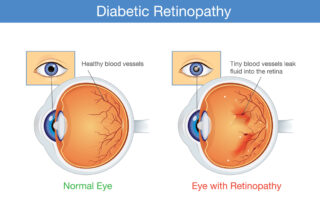
NewView Laser Eye, Inc.
12110 Sunset Hills Road
Suite 50
Reston, VA 20190
NewView Laser Eye, Inc.
20 Davis Ave SW
Leesburg, VA 20175

More Vision & Eye Care Articles
What Is Diabetic Eye Disease?

Approximately 20.8 million Americans have diabetes. More than half of these individuals are at risk for vision loss and other health problems, because they don’t know they have the disease.
Diabetic eye disease, a group of eye problems that affects those with diabetes, includes diabetic retinopathy, cataracts and glaucoma. The most common of these is diabetic retinopathy, which affects 5.3 million Americans age eighteen and older.
Diabetic retinopathy is a potentially vision threatening condition in which the blood vessels inside the retina become damaged from the high blood sugar levels associated with diabetes. This leads to the leakage of fluids into the retina and the obstruction of blood flow. Both may result in vision loss.
The National Eye Institute (NEI), the Federal Government’s lead agency for vision research, urges all people with diabetes to have an eye examination through dilated pupils at least once a year.
Blurred vision may occur when the macula the part of the retina that provides sharp, central vision swells from the leaking fluid. This condition is called macular edema. If new vessels have grown on the surface of the retina, they can bleed into the eye and block vision. But, even in more advanced cases, the disease may progress a long way without symptoms. That is why regular eye examinations for people with diabetes are so important.
More than one third of those diagnosed with diabetes do not receive the recommended vision care and may be at risk for blindness. Because there are often no symptoms in the early stages of diabetic retinopathy, your vision may not be affected until the disease becomes severe.
Once diagnosed with diabetes, schedule a complete dilated eye examination with your eye doctor at least once a year. Make an appointment promptly if you experience blurred vision and floaters that:
- Affect only one eye
- Last more than a few days
- Are not associated with a
- change in blood sugar
In advanced cases of diabetic retinopathy, laser treatment has been shown to reduce the loss of vision. This surgery does not cure diabetic retinopathy, nor does it prevent future vision loss, especially if diabetes or blood pressure is not well controlled.
Diabetes can also affect your vision by causing cataracts and glaucoma. If you have diabetes, you may get cataracts at a younger age and your chances of developing glaucoma are doubled.
Early diagnosis of diabetes and effective control of blood sugar and hypertension through proper diet, exercise and medication can help reduce your risk of developing eye diseases associated with diabetes. Finding and treating the disease early, before it causes vision loss or blindness, is the best way to control diabetic eye disease. So, if you have diabetes, make sure you get a dilated eye examination at least once a year.
Other Articles You May Find of Interest...
- Dry Eye Relief Is In Sight With Optilight
- iDesign Advanced WaveScan Studio
- Norcross Vision Innovators: Glaucoma and Cataract Solutions
- Exploring the Benefits Of Intense Pulsed Light (IPL) For Ocular Surface Health
- Lose Years Off Your Face In Just One Hour
- How to Find a Great Online Shop Offering Same Day Glasses Shipping: Your Quick Guide
- March Is Workplace Eye Wellness Month

















